Queens gets no respect, at least among the other four of New York’s boroughs, who can’t shed the rough, pizzazz-less, blue collar image of it. Besides, that’s where perennial losers The Mets play. Such attitudes long kept Queens off the tourism map, but change is well underway, as neighborhoods like Astoria, Sunnyside, and Long Island City gentrify post-haste.
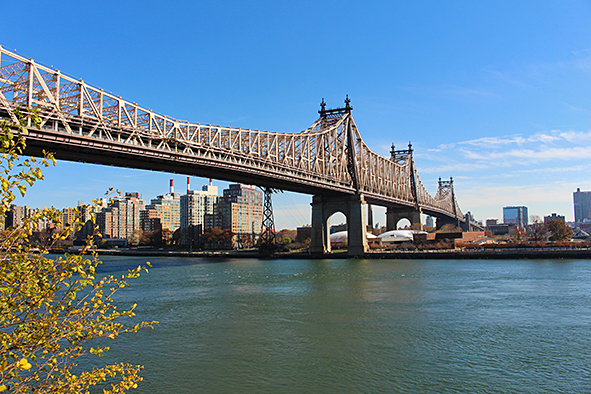
Queensboro Bridge (Photo: Paul Stafford)
No greater evidence can be found than the recognition of Queens by Lonely Planet as the top US Destination in 2015, albeit much to the “say what?” of New Yorkers everywhere. Assuage any doubts by visiting these 10 unique attractions of Queens, New York.
1. Louis Armstrong House Museum
Jazz legend Louie Armstrong could have lived anywhere he wanted to in New York but chose this average-looking house in steadfastly blue-collar Flushing. Here, the trumpeter and his wife spent 28 years together until his death in 1971. Little appears to have changed since. The cigarette stains are still in the sofa, ashtrays on the tables, tape wrapped around the reel-to-reels, and Satchmo’s eyeglasses still sit on a desk, as if put down for only a moment. The custom-built, lacquered blue, mid-century kitchen is particularly notable in all its Mad Men-esque glory, but the loudest gasps come in the bathrooms. The couple invested heavily in them, being avid users of the laxative Swiss Kriss (sold in the gift shop). Marble sinks, gold-plated swan-head, and wrap-around mirrors galore provide a suitable throne room for one of the kings of jazz.
34-56 107th St., Flushing
2. Socrates Sculpture Park
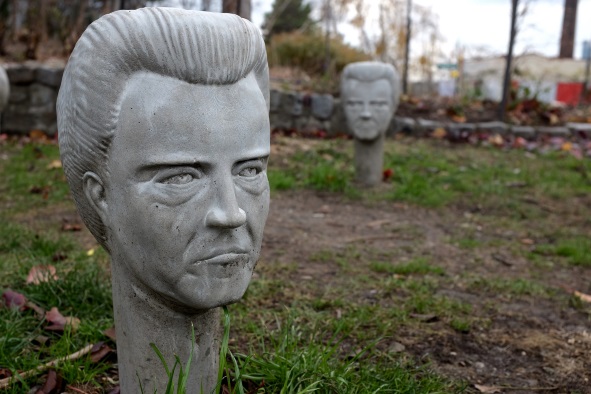
Christoper Walken at Socrates Sculpture Park (Photo: Peter Burka via Flickr / CC BY 2.0)
Astoria’s Greek heritage gave rise to naming this park after the philosopher; an homage the area’s pursuit of intellectual and philosophical discovery. Both are channeled into the seasonal exhibitions of large-scale, outdoor sculpture against the backdrop of the East River, Roosevelt Island, and Manhattan Skyline. More than a dozen “works-that-make-you-go-hmm” wind through the five acres, including instillations like a 1989 Jeep Comanche repurposed into a vitrine for butterflies, a mosaicked baby grand piano envisioned as architecture, and concrete cast busts of Astoria-born actor Christopher Walken. Come in spring and add bouquets of blossoming roses, daffodils and sun flowers.
32-01 Vernon Blvd., Long Island City
3. Bohemian Hall and Beer Garden
Often the first reason anybody comes to Queens, this beer garden is New York City’s oldest and largest. Originally an outgrowth of the Bohemian Citizens’ Benevolent Society of Astoria, established in 1892 to support local Czech and Slovak immigrants, the one-acre garden is now a go-to destination for thirsty locals on warm days. On weekends and holidays it quickly reaches its maximum capacity of 650. Often adding to the fun are live bands, broadcasts of soccer matches, and boisterous games of Cards Against Humanity, all washed down with pitchers of Czech beer and platters of sizzling sausages and schnitzels.
2919 24th Ave., Astoria, 718-274-4925
4. The Queens Giant in Alley Pond Park
This park sandwiched between the Long Island and Cross Island Expressways may only be the borough’s second largest, but it can claim host to the oldest living thing in New York City: a 134-foot tulip poplar around 400 years old, affectionately called “The Queens Giant.” As the sign in front reads, “It was standing tall when General George Washington passed close by in 1790 on a tour of Long Island, and it was most likely a young tree when the Dutch East India Company sent a group of Walloon families to Manhattan in 1624.” How long it keeps the title may depend on a bit more TLC from the parks department and citizens, who still crawl into the blackened interior.
Union Tpke, Oakland Gardens
5. Panorama of the City of New York at Queens Museum
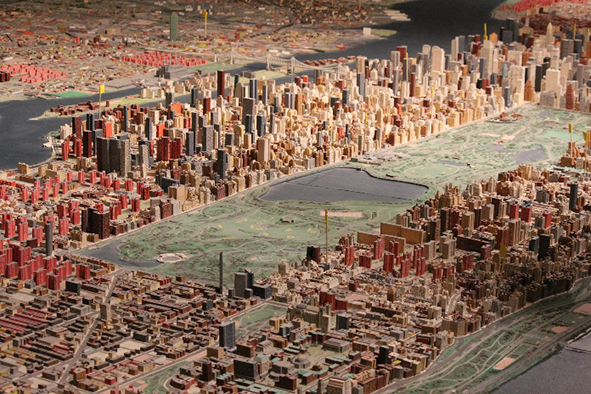
Handmade map of New York City with 895,000 individual structures (Photo: Shinya Suzuki via Flickr / CC BY 2.0)
The World’s Fair of 1964 endowed Queens with numerous unique structures, including the New York State Pavilion and the Unisphere in Flushing Park. But probably none are more impressive than this panoramic model of the entire city in miniature. Built by a team of more than 100 people over three years, the model contains over 895,000 individual structures; made from wood, plastic and hand-painted paper; totaling 9,335 square feet, or 320 square miles of New York City. Manhattan alone stretches 70 feet. Additions and updates have been sporadic, but every building before 1992 is represented. The map remains a centerpiece of the Queens Museum.
Flushing Meadows Corona Park
6. (Ed Koch) Queensboro Bridge
In The Great Gatsby, author F. Scott Fitzgerald wrote “The city seen from the Queensboro Bridge is always the city seen for the first time, in its first wild promise of all the mystery and the beauty in the world.” The honking traffic at rush hour may sometimes make it difficult to appreciate it still to the same degree. However, the views of the East River, Roosevelt Island (directly underneath), and Manhattan from the refreshingly uncrowded walkway on the north side remain impressive, particularly compared to Brooklyn Bridge. The structure itself is worth some attention too. Opened in 1909, the 7,449-foot span was the longest cantilever bridge in the United States. Designated a landmark in 1973, it is a regular feature in film and television.
7. Fort Totten
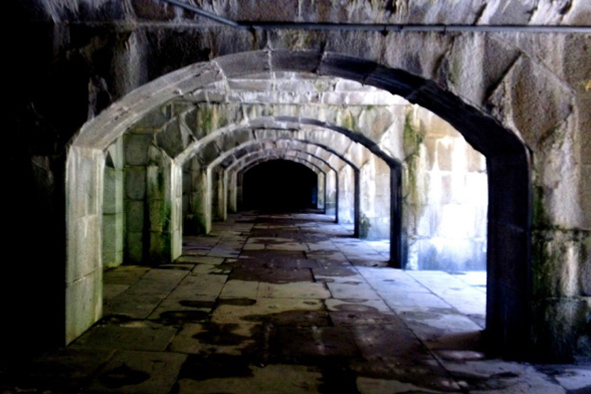
Explore the remains of a Civil War-era Fort Totten (Photo: Terry Ballard via Flickr / CC BY 2.0)
Built in earnest at the start of the Civil War (ironically based on plans of Robert E .Lee), to protect the entrance to the East River, this fort remained in full employment by the military until the 1970s. At one point it was used as a stockpile for Nike missiles and anti-aircraft batteries. Today, the remains of the Civil War-era fort and surrounding army base—including the former officer’s quarters, movie theatre, laboratories, and hospital—form the hub of a 60-acre park open to everyone. Only a few areas remain off-limits, set aside for training by the fire and police departments and the Army Reserve. The handsome neo-Gothic “castle” in the center is home to the Bayside Historical Society.
Totten Ave & 15 Rd., Bayside
8. The Dragon Elevator at The Factory
Thankfully the new owners of “The Factory,” a former warehouse turned mixed-use office center, decided to save New York’s coolest elevator from the chopping block during the building’s renovation. When the door slides open, green, yellow, and orange paint swirls around the bending metallic walls, at times encircling tiny monster heads poking through, but ultimately converging at the back into the visage of a dragon. Peer into the funky fish-eye mirror at the back, and it feels like entering another dimension. Technically, you could call it the Macy’s dimension, as the elevator (and adjacent dragon sculpture made from an old school bus) is a leftover from the building’s days as a warehouse for the department store giant, who long supported the arts.
30-30 47th Ave., Long Island City
9. Steinway & Sons Factory Tour
Little do people expect the melodious sounds of a Steinway grand piano to come out of Queens, but the company not only built its legendary pianos there, but also added to the borough itself, establishing “Steinway Village” in 1880 for its workers. The complex around the factory included a foundry, sawmill, housing, kindergarten, library, post office, fire department and parks. Now part of Astoria, the factory runs one tour every Tuesday, during which visitors witness the entire process of creating a piano, from the raw wood to the finished product. Groups are small, and demand is high, so book months in advance, perhaps more.
Steinway Pl., Astoria
10. Noguchi Museum
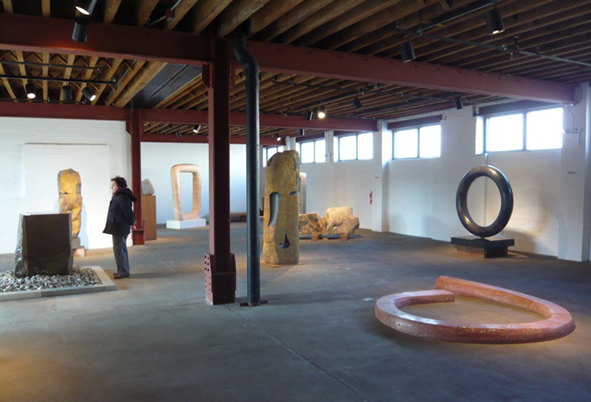
The works of sculptor Isamu Noguchi (Photo: Shinya Suzuki via Flickr / CC BY 2.0)
Nearby Socrates Sculpture Park is a tribute to one of New York’s leading sculptors, Isamu Noguchi, who bestowed many instillations on the city (and world) during the 20th century. These include the nine-ton stainless steel bas-relief “News” above the entrance to the Associated Press building at the Rockefeller Center, the sunken garden in Chase Manhattan Bank Plaza, and the giant red cube outside the HSBC bank and the Bank of America on lower Broadway. The museum itself is also Noguchi’s design, with 10 galleries and an interior sculpture garden, stocked with work he selected from his personal collection.
9-01 33rd Rd., Astoria